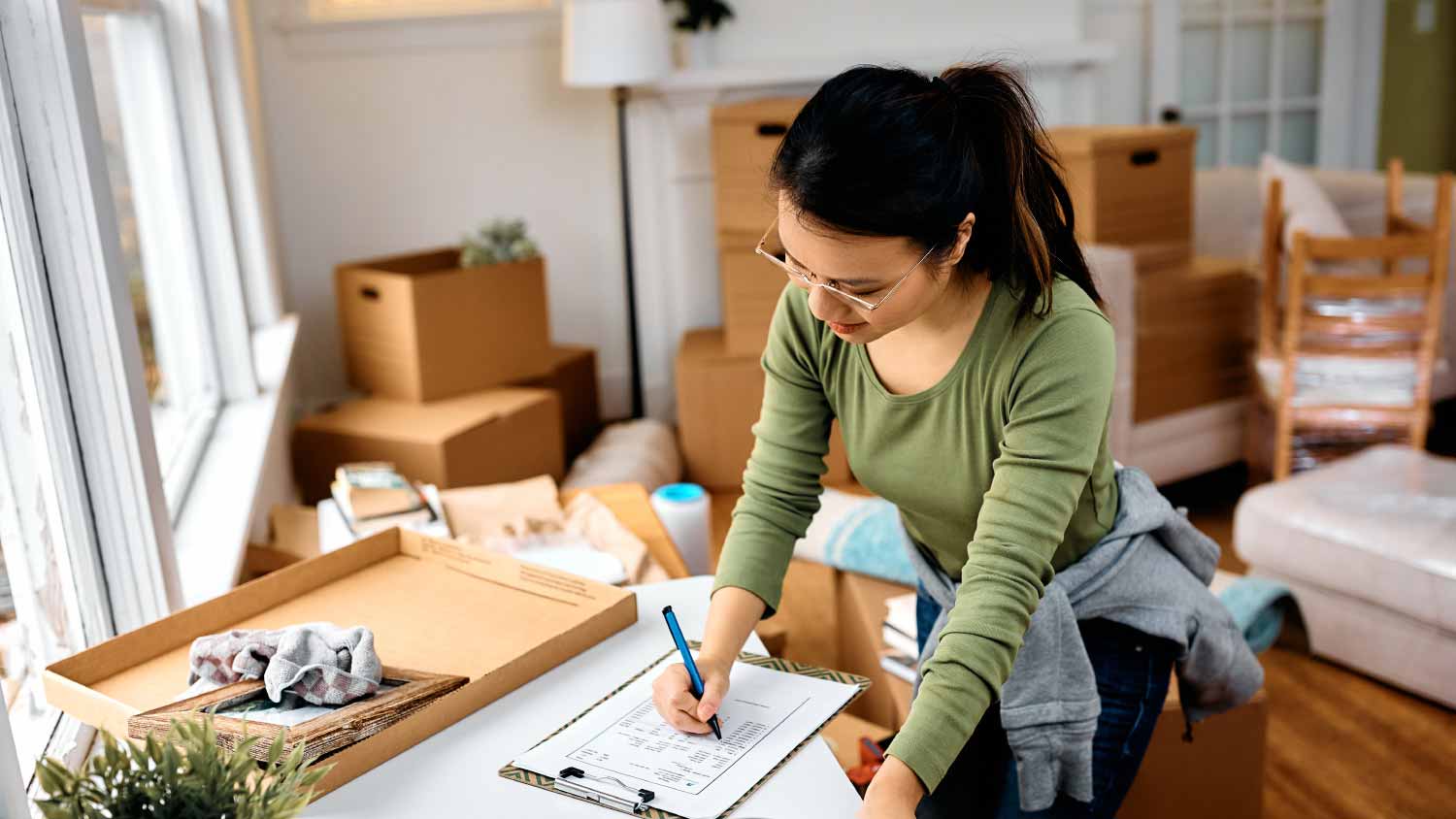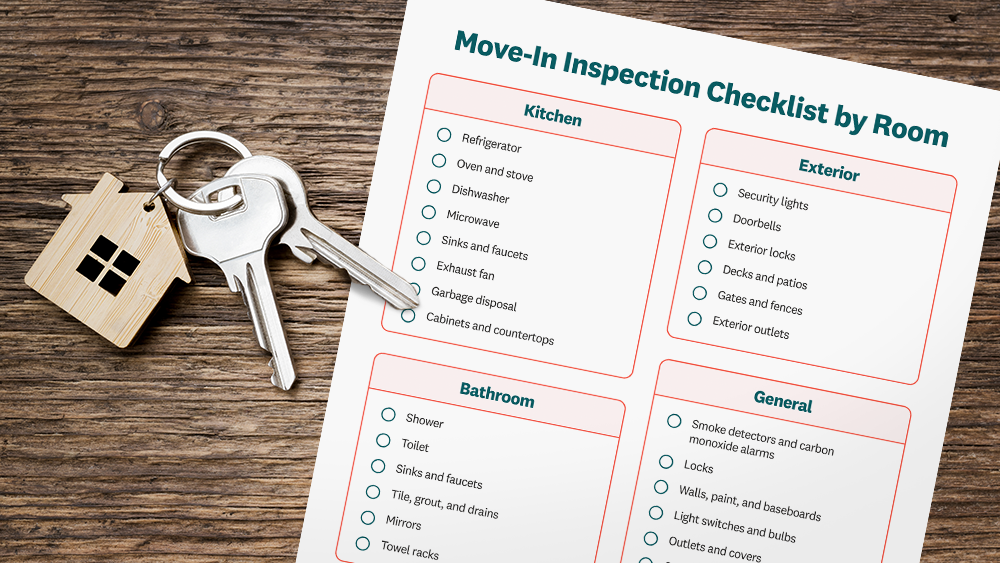Your Essential Move-In Inspection Checklist
Before you move in, cross these inspection items off your list


There’s nothing like the excitement of moving into a new home. But now that you’ve found the perfect spot, it’s important that your new place is safe and ready to live in. A move-in inspection helps assess your space from top to bottom, so you can catch any concerns or problem areas before you get settled in.
Whether you’re going through the space with a landlord, tenant, or your home inspector, having a good inspection checklist helps you know exactly what to look for. That’s why we’ve gathered all the steps in one easy place as well as red flags to watch for while inspecting your new home.
Why Is a Move-In Inspection Important?
A move-in inspection doesn’t just give you peace of mind—it can also help you avoid any disputes if you discover damage in the home. If you’re a home buyer, the best way to ensure a reliable home inspection is to hire a professional. If you’re a landlord, it’s important to be thorough with your move-in checklist, so you can contact the appropriate parties if you find anything beyond normal wear and tear.
For renters, a move-in inspection typically involves:
Walking through the space with your landlord
Signing a checklist where you both agree on the condition of the rental unit
Ensuring you’re both clear on any existing damage so you’re not held responsible
Check up on the condition of appliances
Ask any questions you might have about the apartment
Your landlord may have an apartment move-in inspection checklist that they use, or you can bring your own. If your landlord doesn’t offer a move-in inspection, it may mean it’s not mandatory in your state. However, you can ask to do one, even if it’s not required where you live.
These are the states where rental move-in inspections are required:
Arizona
Georgia
Hawaii
Kansas
Kentucky
Massachusetts
Maryland
Michigan
Montana
Nevada
North Dakota
Virginia
Washington
Wisconsin
For home buyers, a pre-move-in inspection comes in handy in these ways:
Looking at exterior and interior structures as well as home systems like HVAC
Avoiding any surprises that may be hiding in your dream home
Giving you grounds to negotiate before the final sale, if an inspection turns up any major concerns
Alerting you to minor problems before they become major issues
Reminding you to book preventative home maintenance inspections every three to five years
Move-In Inspection Checklist for Homeowners and Renters

Now that you know what happens during a home inspection, it’s time to gather up your checklist and walk through your new space—looking closely at specific spots of each room. Inspection checklists vary from home to home, but the general items below act as a guideline to help you focus on common areas to look out for.
Kitchen
The kitchen is a high-use area in most homes, so it tends to show signs of that use more quickly than other rooms. When you’re doing your walk-through, it’s a good idea to turn on any appliances to make sure that they work properly. You’ll also want to keep an eye out for scratches, dents, and any signs of water damage.
Here are a few kitchen spots that you don’t want to miss:
Refrigerator: Check that the temperatures change and that the lights work, look for water in the drawers or on the bottom of the fridge.
Oven and stove: Check that the timer works, the stove burners turn on, and that the oven light works.
Dishwasher: Open it up to make sure all racks are in place, start it to see if it turns on, and look for water on the bottom.
Microwave: Open it and look for missing parts or stains, turn it on to make sure it works.
Sinks and faucets: Turn each faucet on and test cold and hot water, look for water damage around the base of the faucets or under the sinks.
Exhaust fan: Turn it on and leave it running for a few minutes.
Garbage disposal: Turn it on to make sure it works and sounds good.
Cabinets and countertops: Check for stains, cracks, missing handles, or broken cabinet doors.
Bathroom
Like the kitchen, bathrooms see a lot of use. They’re also more prone to moisture damage, so you’ll want to pay special attention to any signs of mold and mildew in this room.
Check to make sure that all the following spots are sparkling clean:
Shower: Look at the grout and tile to make sure there are no cracks or signs of mold. Test the water to make sure the shower head works and the bottom of the shower doesn’t pool with water.
Toilet: Look in the tank to make sure the parts are in good condition. Test the flush and make sure the seats aren’t broken.
Sinks and faucets: Turn each faucet on and test cold and hot water, look for water damage around the base of the faucets or under the sinks.
Mirrors: Look for cracked or fogged spots.
Towel racks: Test the racks to make sure they’re securely installed.
Laundry and Furnace Room
Laundry and furnace rooms tend to house several major appliances that you’ll need for a comfortable home. In addition to checking the condition of the washer and dryer, take a look at:
Dryer ducts: Look for clogged ducts and make sure there is a clear exit for the duct outside of the house. Check that it has a cover.
HVAC: Check that the air conditioning turns on and take a look at the unit outside of the house.
Furnace: Check the air filter to make sure it’s clean. Test the heat in the house.
Hot water heater: Make sure the pilot light works on the hot water heater. Test the water to make sure it gets hot.
Exterior
Exterior areas don’t necessarily need to be as tidy as the kitchen, but you’ll want to make sure they’re working properly for safety reasons. Take a look at the condition of these fixtures:
Locks: Check that all your keys turn smoothly in the lock and that locks are screwed in tightly.
Security lights: Walk by them to make sure they turn on with motion. Locate switches for the lights and check that they turn the lights on and off.
Doorbells: Ensure they work, and if they’re video doorbells, make sure you get the information to sign up for alerts.
Decks and patios: Look for broken deck boards, check gates, and look at stained areas or damaged areas due to water damage.
Gates and fences: Check that they all open and lock. Look for broken fence boards.
Exterior outlets: Plug something into the outlets to make sure they work and are protected for outdoor use.
Living Room, Bedrooms, and Other Interior Rooms
When you walk through the space, keep an eye on carpets, floors, and the inside of closets—these areas can also hide stains. As you continue to go through your inspection, confirm the cleanliness and working order of these general items as well:
Baseboards and walls: Check for scuffs, scratches, and dirt.
Smoke detectors and carbon monoxide alarms: Push the test button on each to make sure they work properly and that there is one installed in each room.
Locks: Check interior door locks to make sure they all work.
Light switches and bulbs: Locate all light switches to ensure you know which switch controls each light. Make sure all bulbs are working.
Outlets and covers: Test a sample of outlets and ensure all the outlet covers are in good condition.
Fireplaces and chimneys: Ask about fireplaces and if they’re in working condition. Ask when the last chimney cleaning was.
Windows and window coverings: Open and close all windows to ensure they aren’t painted shut. Look for window screens and mark any that are missing. Look at blind to make sure they aren’t broken.
Thermostats: Test that they work and control the furnace and air conditioning accurately.
Vents and covers: Look at floor or ceiling vents and make sure they have coverings that fit securely.

Signs of Damage During a Move-In Inspection
In general, you’ll be keeping an eye out for any signs of damage as you do your walk-through. To help you out, the smaller checklist below outlines major red flags you may notice as you walk through your new home.
Remember, if you do see anything major, it’s best to call in a professional to assess the issue more thoroughly and determine what needs to be fixed.
Keep an eye out for issues like:
Cracks: Check walls and ceilings
Discoloration: Look for yellowing on the walls or mildew in the bathrooms
Smells: Pay attention to burning smells or mustiness, especially in damp areas like bathrooms and laundry rooms
Warm/hot patches: Feel for warm sections on the wall, which can be a sign of electrical failure
Signs of pest damage: Pay attention to baseboards and the backs of cupboards, especially in kitchens and eating areas
Move In Without the Stress
If it feels like there are a lot of items on your moving-into-a-new-house checklist, you’re right! There’s a lot to do before settling into a new home. However, finding a local home inspector who has your back can take one thing off of your to-do list.
Talk with the inspector about the move-in inspection checklist items and make sure you’re both on the same page when it comes to signs of damage and possible repairs. Professional inspectors know exactly what to look for before you move in, so you can feel secure stepping into your next rental property or new dream home.





- Your Ultimate Move-Out Inspection Checklist
- What to Expect During a Home Inspection
- What to Expect During a New Construction Home Inspection and a Builder’s Walk-Through
- Hire a Pro or DIY: The Complete Home Inspection Checklist
- Your All-In-One Home Inspection Checklist for Sellers
- Which Home Projects To Put On Your To-Do List First After Moving
- The Ultimate Home Inspection Checklist For Buyers
- How to Choose a Home Inspector
- 45-Point Moving Cross-Country Checklist
- 12 Types of Home Inspections: A Complete Guide










